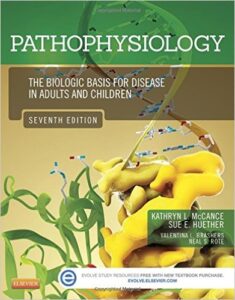Description
Test Bank For Pathophysiology The Biologic Basis for Disease in Adults and Children 7th Edition
Chapter 6: Epigenetics and Disease
MULTIPLE CHOICE
1.What genetic process is likely responsible for the occurrence of asthma in only one of a pair of identical twins?
a. Epigenetic modifications c. Transgenerational inheritance
b. Genomic imprinting d. Methylation
ANS: A
Epigenetic modifications can cause individuals with the same deoxyribonucleic acid (DNA) sequences (such as identical twins) to have different disease profiles. The correct option is the only one that accurately identifies the genetic process likely responsible for the occurrence of asthma in only one of a pair of twins.
PTS:1REF:Page 183 | Page 185
2.Prader-Willi syndrome causes a chromosomal defect that is:
a. Initiated by postnatal exposure to a virus
b. Inherited from the father
c. Related to maternal alcohol abuse
d. Transferred from mother to child
ANS: B
Prader-Willi syndrome can be caused by a 4 Mb deletion of chromosome 15q when inherited from the father. The other options do not accurately identify the reason for the chromosomal damage that causes Prader-Willi syndrome.
PTS:1REF:Pages 187-188
3.A malfunction in DNA methylation can lead to:
a. Hypothyroidism c. Cancer
b. Blindness d. Diabetes mellitus
ANS: C
Aberrant methylation can lead to silencing of tumor-suppressor genes in the development of cancer. No research supports a connection between hypothyroidism, blindness, or diabetes mellitus to a malfunctioning of DNA methylation.
PTS:1REF:Page 183 | Page 186
4.Which statement is true regarding the embryonic development of stem cells?
a. They are already differentiated.
b. They are referred to as housekeeping genes.
c. They already demonstrate DNA sequencing.
d. They are said to be pluripotent.
ANS: D
Early in embryonic development, all cells of the embryo have the potential to become any type of cell in the fetus or adult. These embryonic stem cells are said to be pluripotent. The remaining options are not true statements regarding embryonic stem cell development.
PTS: 1 REF: Page 184
5.When microRNA (miRNA) are methylated their messenger RNA (mRNA) targets are over-expressed, the resulting effect on existing cancer would be:
a. Cell death c. Remission
b. Metastasis d. Relapse
ANS: B
When miRNA genes are methylated, their mRNA targets are over-expressed, and this over-expression has been associated with metastasis. of the described effect on mRNA targets on existing cancer does not result in any of the other options.
PTS: 1 REF: Page 186
6.The difference between DNA sequence mutations and epigenetic modifications is:
a. DNA sequence mutations can be directly altered.
b. Leukemia is a result of only DNA sequence mutation.
c. Epigenetic modifications can be reversed.
d. No known drug therapies are available for epigenetic modifications.
ANS: C
Unlike DNA sequence mutations, which cannot be directly altered, epigenetic modifications can be reversed. The remaining options are not true statements regarding the difference between DNA sequence mutations and epigenetic modifications.
PTS: 1 REF: Page 186
7.Which term refers to the silenced gene of a gene pair?
a. Activated c. Mutated
b. Altered d. Imprinted
ANS: D
Gene silencing, a process during which genes are predictably silenced, depending on which parent transmits them, is known as imprinting; the transcriptionally silenced genes are then said to be imprinted. The remaining options do not accurately identify this process.
PTS: 1 REF: Page 187
8.The shape of the face of a child diagnosed with Russell-Silver syndrome is likely to be:
a. Round c. Triangular
b. Square d. Elongated
ANS: C
Growth retardation, proportionate short stature, leg-length discrepancy, and a small, triangular-shaped face characterizes Russell-Silver syndrome. The other face shapes are not characteristic of Russell- Silver syndrome.
PTS: 1 REF: Page 188
9.Genes responsible for the maintenance of all cells are referred to as:
a. Universal c. Housekeeping
b. Managerial d. Executive
ANS: C
A small percentage of genes, termed housekeeping genes, are necessary for the function and maintenance of all cells. The remaining options do not accurately refer to these cells.
PTS: 1 REF: Page 184
10.What is the belief regarding twins who adopt dramatically different lifestyles?
a. They may experience very different aging processes.
b. They will retain very similar methylation patterns.
c. They will experience identical phenotypes throughout their lifespans.
d. They may never demonstrate similar DNA sequences of their somatic cells.
ANS: A
Twins with significant lifestyle differences (e.g., smoking versus nonsmoking), accumulate large numbers of differences in their methylation patterns. The twins, despite having identical DNA sequences, become more and more different as a result of epigenetic changes, which in turn affect the expression of genes. These results, along with findings generated in animal studies, suggest that changes in epigenetic patterns may be an important part of the aging process. They will not experience identical phenotypes throughout their lifespans.
PTS: 1 REF: Page 185
11.Hypomethylation and the resulting effect on oncogenes result in a(an):
a. Decrease in the activity of the oncogene, thus suppressing cancer development
b. Deactivation of MLH1 to halt DNA repair
c. Increase in tumor progression from benign to malignant
d. Over-expression of microRNA, resulting in tumorigenesis
ANS: C
Tumor cells typically exhibit hypomethylation (decreased methylation), which can increase the activity of oncogenes. Hypomethylation increases as tumors progress from benign neoplasms to malignancy. Only the correct option accurately describes hypomethylation and its resulting effects.
PTS: 1 REF: Page 186
12.When a chromosome lacking 4 Mb is inherited from the mother, the child is at risk for developing which syndrome?
a. Prader-Willi c. Beckwith-Wiedemann
b. Angelman d. Russell-Silver
ANS: B
This anomaly illustrates the inheritance pattern of Angelman syndrome, which can be caused by a 4 Mb deletion of chromosome 15q when inherited from the mother. The anomaly is not the cause of any of the other options.
PTS: 1 REF: Page 187

Reviews
There are no reviews yet.